What is Sinusitis?
Sinusitis is the medical term for inflammation of the sinuses. It is classified as either Acute or Chronic Sinusitis.
What are Nasal Sinuses?
Nasal Sinuses are hollow cavities within the face. There are four pairs of sinuses found on each side of the face called the maxillary, frontal, ethmoid and sphenoid sinuses.
The nasal sinuses are lined with mucus membranes which contain hairlike projections called cilia. These hairs facilitate the drainage of secretions from the sinuses through the narrow passages that lead to the nose.
What is the function of the Sinuses?
The function of nasal sinuses is thought to include warming and humidifying inspired air, improving vocal sound resonance and reducing the weight of the skull.
What causes Sinusitis?
Almost all sinus problems begin inside the nose. The sinuses connect with the internal lining of the nose via narrow passages. These passages must remain clear or the normal drainage and clearance of mucus from the sinuses will be curtailed leading to inflammation of the mucosa. This initially results in sinus pressure but it also produces the ideal conditions for bacterial overgrowth and infection inside the sinuses.
Acute Sinusitis vs Chronic Sinusitis
Acute Sinusitis
Acute Sinusitis refers to a new viral or bacterial infection of the mucosa lining the nasal cavity and paranasal sinuses. This causes a build up of pressure within the sinuses. The symptoms usually consist of unilateral facial sinus pain and a fever.
Chronic Sinusitis
Chronic Sinusitis is inflammation of the sinuses which lasts for at least 3 months. The symptoms typically include facial discomfort or pain corresponding to the affected sinuses. Sinusitis is usually accompanied by allergic rhinitis. The majority of these cases are caused by predisposing allergies to inhalant allergens such as house dust mite, animal dander, pollen and mould. Chronic sinusitis may also be the result of predisposing structural issues such as septal deviation, narrow paranasal channels and nasal polyps. Hormonal changes such as during puberty, pregnancy or menopause can also act as a trigger.
Why are some people more prone to recurrent Acute Sinusitis?
Patients who suffer from Chronic Rhinosinusitis are particularly vulnerable to episodes of Acute Sinusitis as their paranasal sinuses and passages are already compromised. This is usually the result of either inhalant allergies but it may also be due to congenital or acquired structural sinus issues.
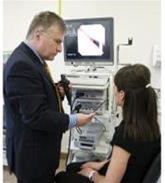 How is Sinusitis Diagnosed?
How is Sinusitis Diagnosed?
In order to establish the correct diagnosis it is recommended to combine thorough history taking with endoscopic examination of the nasal cavity. Skin prick allergy testing is used to assess whether inhalant allergies are a contributing factor. This is particularly useful in cases of recurrent Acute Sinusitis or Chronic Rhinosinusitis. Sometimes CT imaging of the sinuses may also be warranted.
Treatment of Sinusitis
Acute and Chronic Sinusitis require different approaches to treatment.
How is Acute Bacterial Sinusitis treated?
- Acute Bacterial Sinusitis is treated with a course of antibiotics which are usually given for about ten days.
- Steroid drops may be used to unblock the obstructed paranasal passages and sinuses.
- Short term use of decongestants tablets such as pseudoephedrine and decongestant nasal sprays containing xylometazoline may also be useful. Paracetamol and ibuprofen can be used in combination if analgesia is required.
How is Chronic Sinusitis treated?
- Chronic Rhinosinusitis is treated with long term steroid sprays to reduce the inflammation and swelling of the nasal mucosa. The most recent generation of these nasal sprays are recommended as they have almost no systemic absorption and are therefore very safe. e.g. Nasonex (mometasone) and Avamy's (fluticasone).
- Nasal irrigation with saline rinses help clear secretions, remove allergens and improve mucociliary clearance.
- Non-drug options such as Rhinolight and Immunotherapy are also available.
- If an anatomical reason is found for chronic sinusitis then this may need to be surgically corrected.
Contact Us to Schedule Your Consultation
If chronic sinusitis is impacting your quality of life, schedule an appointment for assessment and treatment.
Contact us today to arrange your appointment with one of our specialist allergy doctors.
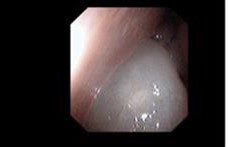 Nasal Polyps
Nasal Polyps
What are nasal polyps?
Nasal Polyps are benign painless fleshy growths that form inside the nose and sinuses.
What causes nasal polyps?
Nasal polyps may occur for a variety of reasons and there is not necessarily a single cause. We know that nasal polyps are more likely to occur in the context of inhalent allergies to allergens such as house dust mite, chronic inflammation of the nasal passages and recurrent infections. Genetic predisposition also plays a role and nasal polyps often run in families.
What problems can nasal polyps cause?
Nasal polyps can cause mechanical problems within the nose by obstructing the nasal passages and the narrow connections to the sinuses. This results in reduced airflow and breathing problems, diminished sense of smell and taste, sinus pressure and recurrent sinus infections. It is therefore important to treat the allergic triggers that potentiate chronic inflammation of the nasal passages. This includes house dust mite, pollen and animal dander allergy. Nasal polyps do not become cancerous.
How are nasal polyps treated?
Steroid nasal drops and sprays are used to help curtail the growth of nasal polyps. In patients who also suffer from inhalant allergies it is important to adopt allergen avoidance measures to minimise ongoing exposures. Allergen desensitisation known as Immunotherapy can also be considered.
If nasal polyps are causing significant symptoms then surgical removal is recommended. Following surgery it is important to continue medical management to help reduce the risk of recurrence.
What might I experience when my sinuses become inflamed or infected?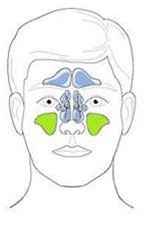
The green demarcated area denotes the maxillary sinuses which are located just behind the cheekbones. Inflammation and swelling of the maxillary sinuses causes:
- Cheek pain/pressure
- Toothache
- Headache
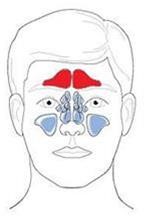
The red area identifies the frontal sinuses which are located just above the eyebrows. Inflammation and swelling of the frontal sinuses causes:
- Pain around and behind the eyes
- Headaches
- May trigger migraine
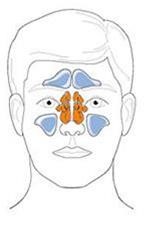
The orange area denotes the ethmoid and sphenoid sinuses. The ethmoids are located between the eyes and just behind the bridge of the nose. Behind the ethmoid sinuses, tucked in behind the eyes are the sphenoid sinuses. Inflammation and swelling in either or both may cause:
- Pain/pressure between and behind the eyes
- Headaches
Case 1
 This 17 year old male presented with long history of nasal obstruction, headaches and a runny nose. Nasoendoscopy revealed a grossly swollen nasal lining obstructing the sinus openings. CT imaging showed that the ethmoid and maxillary sinuses were thickened. These changes were the result of chronic inflammation and obstruction of the entrances to the sinuses.
This 17 year old male presented with long history of nasal obstruction, headaches and a runny nose. Nasoendoscopy revealed a grossly swollen nasal lining obstructing the sinus openings. CT imaging showed that the ethmoid and maxillary sinuses were thickened. These changes were the result of chronic inflammation and obstruction of the entrances to the sinuses.
Case 2: Rhinitis is often associated with Sinusitis as inflammation of the nose can progress into the adjoining sinuses.
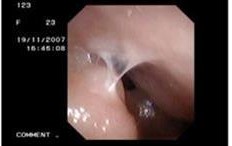 In this image there is severe swelling of the lining in the nasal cavity causing symptoms such as blockage, mouth breathing, diminished sense of smell and taste. In this case, the inflammation was triggered by an aggressive allergy to dust mites and grass pollens.
In this image there is severe swelling of the lining in the nasal cavity causing symptoms such as blockage, mouth breathing, diminished sense of smell and taste. In this case, the inflammation was triggered by an aggressive allergy to dust mites and grass pollens.
Case 3
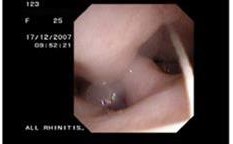 This image is taken from a 25 year old with allergic rhinitis. The internal surface of the nose is so allergically irritated that fluid is beginning to swell the lining. If left untreated, the shiny bubble-like area at 8 o’clock will become a polyp. In long standing nose and sinus allergy, if an infection occurs in addition to the background changes then considerable extra damage can be inflicted on the soft tissue.
This image is taken from a 25 year old with allergic rhinitis. The internal surface of the nose is so allergically irritated that fluid is beginning to swell the lining. If left untreated, the shiny bubble-like area at 8 o’clock will become a polyp. In long standing nose and sinus allergy, if an infection occurs in addition to the background changes then considerable extra damage can be inflicted on the soft tissue.
Case 4
 Even in children as young as 5 years of age, considerable swelling can occur within the nasal cavity. This in turn obstructs the sinus openings causing sinus problems. And in turn may act as a trigger or aggravating factor in asthma. If the nose and sinus problems are treated then asthma may improve significantly.
Even in children as young as 5 years of age, considerable swelling can occur within the nasal cavity. This in turn obstructs the sinus openings causing sinus problems. And in turn may act as a trigger or aggravating factor in asthma. If the nose and sinus problems are treated then asthma may improve significantly.


